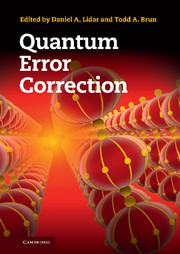Book contents
- Frontmatter
- Contents
- List of contributors
- Prologue
- Preface and guide to the reader
- Acknowledgements
- Part I Background
- Part II Generalized approaches to quantum error correction
- Part III Advanced quantum codes
- Part IV Advanced dynamical decoupling
- Part V Alternative quantum computation approaches
- Part VI Topological methods
- Part VII Applications and implementations
- 21 Experimental quantum error correction
- 22 Experimental dynamical decoupling
- 23 Architectures
- 24 Error correction in quantum communication
- Part VIII Critical evaluation of fault tolerance
- References
- Index
24 - Error correction in quantum communication
from Part VII - Applications and implementations
Published online by Cambridge University Press: 05 September 2013
- Frontmatter
- Contents
- List of contributors
- Prologue
- Preface and guide to the reader
- Acknowledgements
- Part I Background
- Part II Generalized approaches to quantum error correction
- Part III Advanced quantum codes
- Part IV Advanced dynamical decoupling
- Part V Alternative quantum computation approaches
- Part VI Topological methods
- Part VII Applications and implementations
- 21 Experimental quantum error correction
- 22 Experimental dynamical decoupling
- 23 Architectures
- 24 Error correction in quantum communication
- Part VIII Critical evaluation of fault tolerance
- References
- Index
Summary
Introduction
Many of the chapters in this book have developed the theory of quantum error correction (QEC) for the specific purpose of building a fault-tolerant, reliable quantum computer. Specifically, Chapter 5 shows how the theory of QEC is a core component in the theory of fault-tolerant quantum computation. Fault-tolerant quantum computation has received much attention from the theoretical quantum information community because it is a key requirement for a scalable quantum computer. The most celebrated tasks that one could perform with a fault-tolerant quantum computer are factoring a prime number [S94b, S97], searching a database quickly [G96b, G97b], or simulating a quantum system efficiently [F82, L96].
One can exploit quantum phenomena to enhance communication as well. The field of quantum communication encompasses any aspect of quantum theory that is exploited for communicative purposes. In this chapter, we discuss four main topics involving QEC in quantum communication:
(i) entanglement distillation,
(ii) a security proof of quantum key expansion,
(iii) continuous-variable systems, and
(iv) implementation of QEC for the purpose of quantum communication.
We first comment briefly on each of the above topics. Entanglement distillation converts a set of noisy ebits to a smaller set of noiseless ones. It is useful to have a procedure for entanglement distillation because noiseless entanglement is the core resource in several quantum communication protocols. We show how the techniques from QEC apply to entanglement distillation. A security proof for quantum key expansion is a mathematical proof that shows that a quantum key expansion protocol is secure against an arbitrary attack by an eavesdropper.
- Type
- Chapter
- Information
- Quantum Error Correction , pp. 553 - 582Publisher: Cambridge University PressPrint publication year: 2013

